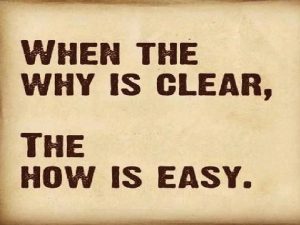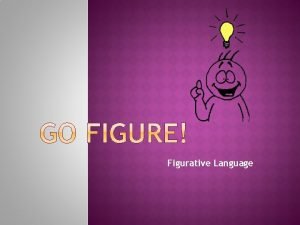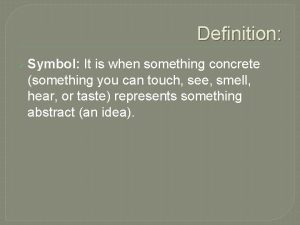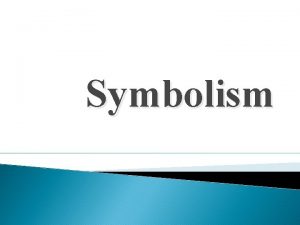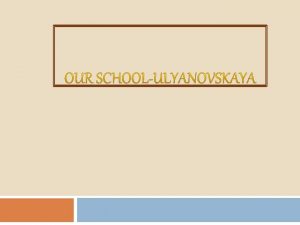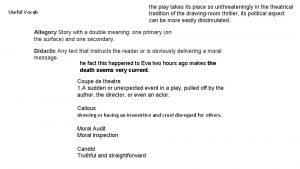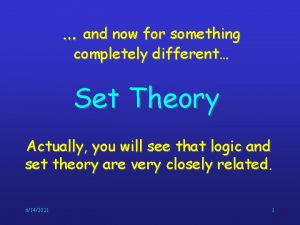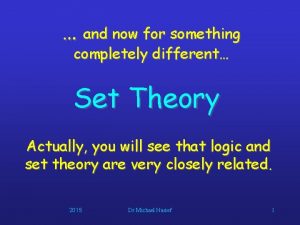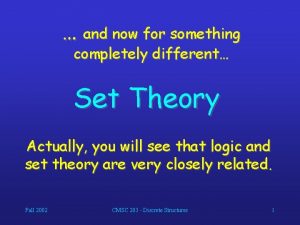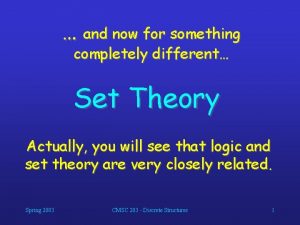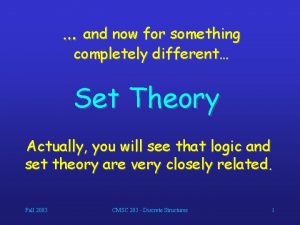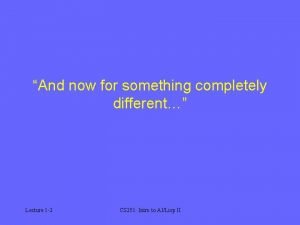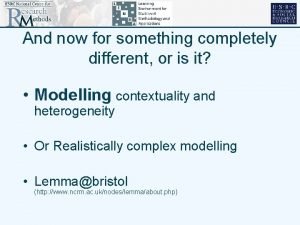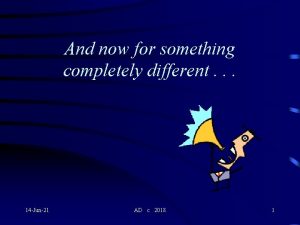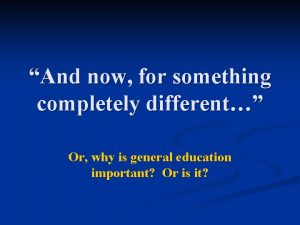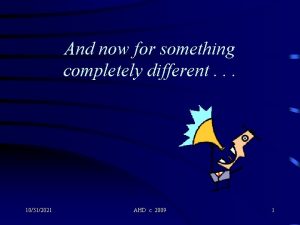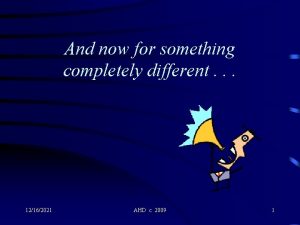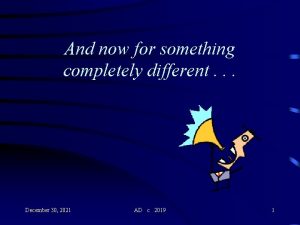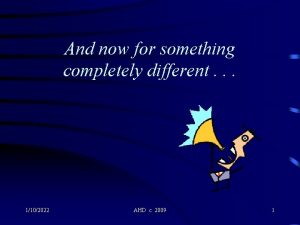and now for something completely different Set Theory





















- Slides: 21

… and now for something completely different… Set Theory Actually, you will see that logic and set theory are very closely related. Fall 2002 CMSC 203 - Discrete Structures 1

Set Theory • Set: Collection of objects (“elements”) • a A “a is an element of A” “a is a member of A” • a A “a is not an element of A” • A = {a 1, a 2, …, an} “A contains…” • Order of elements is meaningless • It does not matter how often the same element is listed. Fall 2002 CMSC 203 - Discrete Structures 2

Set Equality Sets A and B are equal if and only if they contain exactly the same elements. Examples: • A = {9, 2, 7, -3}, B = {7, 9, -3, 2} : A=B • A = {dog, cat, horse}, B = {cat, horse, squirrel, dog} : A B • A = {dog, cat, horse}, B = {cat, horse, dog} : A=B Fall 2002 CMSC 203 - Discrete Structures 3

Examples for Sets “Standard” Sets: • Natural numbers N = {0, 1, 2, 3, …} • Integers Z = {…, -2, -1, 0, 1, 2, …} • Positive Integers Z+ = {1, 2, 3, 4, …} • Real Numbers R = {47. 3, -12, , …} • Rational Numbers Q = {1. 5, 2. 6, -3. 8, 15, …} (correct definition will follow) Fall 2002 CMSC 203 - Discrete Structures 4

Examples for Sets • • A= “empty set/null set” A = {z} Note: z A, but z {z} • A = {{b, c}, {c, x, d}} • A = {{x, y}} Note: {x, y} A, but {x, y} {{x, y}} • A = {x | P(x)} “set of all x such that P(x)” • A = {x | x N x > 7} = {8, 9, 10, …} “set builder notation” Fall 2002 CMSC 203 - Discrete Structures 5

Examples for Sets We are now able to define the set of rational numbers Q: Q = {a/b | a Z b Z+} or Q = {a/b | a Z b 0} And how about the set of real numbers R? R = {r | r is a real number} That is the best we can do. Fall 2002 CMSC 203 - Discrete Structures 6

Subsets A B “A is a subset of B” A B if and only if every element of A is also an element of B. We can completely formalize this: A B x (x A x B) Examples: A = {3, 9}, B = {5, 9, 1, 3}, A B ? true A = {3, 3, 3, 9}, B = {5, 9, 1, 3}, A B ? true A = {1, 2, 3}, B = {2, 3, 4}, Fall 2002 CMSC 203 - Discrete Structures A B ? false 7

Subsets Useful rules: • A = B (A B) (B A) • (A B) (B C) A C (see Venn Diagram) U B Fall 2002 A C CMSC 203 - Discrete Structures 8

Subsets Useful rules: • A for any set A • A A for any set A Proper subsets: A B “A is a proper subset of B” A B x (x A x B) x (x B x A) or A B x (x A x B) x (x B x A) Fall 2002 CMSC 203 - Discrete Structures 9

Cardinality of Sets If a set S contains n distinct elements, n N, we call S a finite set with cardinality n. Examples: A = {Mercedes, BMW, Porsche}, |A| = 3 B = {1, {2, 3}, {4, 5}, 6} C= D = { x N | x 7000 } |B| = 4 |C| = 0 |D| = 7001 E = { x N | x 7000 } E is infinite! Fall 2002 CMSC 203 - Discrete Structures 10

The Power Set P(A) “power set of A” P(A) = {B | B A} (contains all subsets of A) Examples: A = {x, y, z} P(A) = { , {x}, {y}, {z}, {x, y}, {x, z}, {y, z}, {x, y, z}} A= P(A) = { } Note: |A| = 0, |P(A)| = 1 Fall 2002 CMSC 203 - Discrete Structures 11

The Power Set Cardinality of power sets: | P(A) | = 2|A| • Imagine each element in A has an “on/off” switch • Each possible switch configuration in A corresponds to one element in 2 A A x y z 1 x y z 2 x y z 3 x y z 4 x y z 5 x y z 6 x y z 7 x y z 8 x y z • For 3 elements in A, there are 2 2 2 = 8 elements in P(A) Fall 2002 CMSC 203 - Discrete Structures 12

Cartesian Product The ordered n-tuple (a 1, a 2, a 3, …, an) is an ordered collection of objects. Two ordered n-tuples (a 1, a 2, a 3, …, an) and (b 1, b 2, b 3, …, bn) are equal if and only if they contain exactly the same elements in the same order, i. e. ai = bi for 1 i n. The Cartesian product of two sets is defined as: A B = {(a, b) | a A b B} Example: A = {x, y}, B = {a, b, c} A B = {(x, a), (x, b), (x, c), (y, a), (y, b), (y, c)} Fall 2002 CMSC 203 - Discrete Structures 13

Cartesian Product The Cartesian product of two sets is defined as: A B = {(a, b) | a A b B} Example: A = {good, bad}, B = {student, prof} } A B = { (good, student), (good, prof), (bad, student), (bad, prof) B A = { (student, good), (prof, good), (student, bad), (prof, bad) Fall 2002 CMSC 203 - Discrete Structures } 14

Cartesian Product Note that: • A = • A = • For non-empty sets A and B: A B B A • |A B| = |A| |B| The Cartesian product of two or more sets is defined as: A 1 A 2 … An = {(a 1, a 2, …, an) | ai A for 1 i n} Fall 2002 CMSC 203 - Discrete Structures 15

Set Operations Union: A B = {x | x A x B} Example: A = {a, b}, B = {b, c, d} A B = {a, b, c, d} Intersection: A B = {x | x A x B} Example: A = {a, b}, B = {b, c, d} A B = {b} Fall 2002 CMSC 203 - Discrete Structures 16

Set Operations Two sets are called disjoint if their intersection is empty, that is, they share no elements: A B = The difference between two sets A and B contains exactly those elements of A that are not in B: A-B = {x | x A x B} Example: A = {a, b}, B = {b, c, d}, A-B = {a} Fall 2002 CMSC 203 - Discrete Structures 17

Set Operations The complement of a set A contains exactly those elements under consideration that are not in A: Ac = U-A Example: U = N, B = {250, 251, 252, …} Bc = {0, 1, 2, …, 248, 249} Fall 2002 CMSC 203 - Discrete Structures 18

Set Operations Table 1 in Section 1. 5 shows many useful equations. How can we prove A (B C) = (A B) (A C)? Method I: x A (B C) x A x (B C) x A (x B x C) (x A x B) (x A x C) (distributive law for logical expressions) x (A B) x (A C) x (A B) (A C) Fall 2002 CMSC 203 - Discrete Structures 19

Set Operations Method II: Membership table 1 means “x is an element of this set” 0 means “x is not an element of this set” A B C A (B C) A B A C (A B) (A C) 0 0 0 0 0 1 0 0 0 1 1 1 1 0 0 0 1 1 1 0 0 1 1 1 Fall 2002 CMSC 203 - Discrete Structures 20

Set Operations Every logical expression can be transformed into an equivalent expression in set theory and vice versa. You could work on Exercises 9 and 19 in Section 1. 5 to get some practice. Fall 2002 CMSC 203 - Discrete Structures 21
 Now may the god of peace himself
Now may the god of peace himself Total set awareness set consideration set
Total set awareness set consideration set Training set validation set test set
Training set validation set test set Explaining how something works
Explaining how something works Symbolism of concrete
Symbolism of concrete Smart is not something you are
Smart is not something you are Open oven
Open oven Theme vs topic
Theme vs topic Symbol/symbolism definition
Symbol/symbolism definition Something old something new poem
Something old something new poem Adjective language feature
Adjective language feature Now i see it now you don't
Now i see it now you don't Which of the seven deadly sins does mrs birling embody
Which of the seven deadly sins does mrs birling embody It is the arrangement or classification
It is the arrangement or classification What is the overlap of data set 1 and data set 2?
What is the overlap of data set 1 and data set 2? Bounded set vs centered set
Bounded set vs centered set Fuzzy logic
Fuzzy logic Crisp set vs fuzzy set
Crisp set vs fuzzy set Crisp set vs fuzzy set
Crisp set vs fuzzy set The function from set a to set b is
The function from set a to set b is Formuö
Formuö Novell typiska drag
Novell typiska drag





